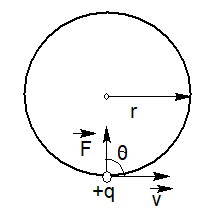
An electron, moving in a uniform magnetic field of induction of intensity $\vec{B}$, has its radius directly proportional to
A. Its charge
B. Magnetic field
C. Speed
D. None of these
Answer
218.1k+ views
Hint: When an electron moves in a uniform magnetic field with a definite velocity it experiences a perpendicular magnetic force. The magnetic force becomes a centripetal force due to its direction towards the circular path of radius $r$. Then by equating magnetic force and centripetal force we can easily find out the magnitude of the radius $r$.
Complete answer:
In a uniform magnetic field $\vec{B}$ when a charged particle (electron) $q$ moves with uniform velocity $\vec{v}$,

then force experienced by the charged particle can be expressed as
$\vec{F}=q(\vec{v}\times \vec{B})$
Or, $F=qvB\sin \theta $
Or,$F=qvB\sin {{90}^{o}}$ [since $\theta ={{90}^{o}}$, the angle between magnetic field vector $\vec{B}$and velocity vector $\vec{v}$]
Or,$F=qBv$ ………(i)
This magnetic force is perpendicular to the velocity of the electron and acts as the centripetal force of the moving electron through the circular path.
That $F$ is a centripetal force for circular motion and thereby can be expressed as
$F=\dfrac{m{{v}^{2}}}{r}$ ……..(ii)
Then by equating equations (i) and (ii) we get,
$qBv=\dfrac{m{{v}^{2}}}{r}$
Or,$r=\dfrac{mv}{qB}$
$\therefore r$ $\alpha $$v$
That is the radius of the circular path is directly proportional to the speed of an electron in a uniform magnetic field $B$.
Additional information: A charged particle in a stationary state will not interact with the uniform magnetic field, but when a charged particle moves in a magnetic field will interact. The magnetic force is higher when a charged particle moves in a direction of magnetic field lines and to the velocity of the particle.
Note: The magnetic force does not change the speed of charged particles but only changes the direction of motion. The magnetic force is zero when the particle moves parallel to the magnetic field lines and therefore no deflection occurs.
Complete answer:
In a uniform magnetic field $\vec{B}$ when a charged particle (electron) $q$ moves with uniform velocity $\vec{v}$,

then force experienced by the charged particle can be expressed as
$\vec{F}=q(\vec{v}\times \vec{B})$
Or, $F=qvB\sin \theta $
Or,$F=qvB\sin {{90}^{o}}$ [since $\theta ={{90}^{o}}$, the angle between magnetic field vector $\vec{B}$and velocity vector $\vec{v}$]
Or,$F=qBv$ ………(i)
This magnetic force is perpendicular to the velocity of the electron and acts as the centripetal force of the moving electron through the circular path.
That $F$ is a centripetal force for circular motion and thereby can be expressed as
$F=\dfrac{m{{v}^{2}}}{r}$ ……..(ii)
Then by equating equations (i) and (ii) we get,
$qBv=\dfrac{m{{v}^{2}}}{r}$
Or,$r=\dfrac{mv}{qB}$
$\therefore r$ $\alpha $$v$
That is the radius of the circular path is directly proportional to the speed of an electron in a uniform magnetic field $B$.
Additional information: A charged particle in a stationary state will not interact with the uniform magnetic field, but when a charged particle moves in a magnetic field will interact. The magnetic force is higher when a charged particle moves in a direction of magnetic field lines and to the velocity of the particle.
Note: The magnetic force does not change the speed of charged particles but only changes the direction of motion. The magnetic force is zero when the particle moves parallel to the magnetic field lines and therefore no deflection occurs.
Recently Updated Pages
Arithmetic, Geometric & Harmonic Progressions Explained

Cartesian Form of Vector Explained: Formula, Examples & Uses

Apparent Frequency Explained: Formula, Uses & Examples

Calorimetry: Definition, Principles & Calculations

Centrifugal Force Explained: Definition, Formula & Examples

Charge in a Magnetic Field: Definition, Formula & Examples

Trending doubts
JEE Main 2026: Application Form Open, Exam Dates, Syllabus, Eligibility & Question Papers

Derivation of Equation of Trajectory Explained for Students

Hybridisation in Chemistry – Concept, Types & Applications

Understanding the Angle of Deviation in a Prism

Understanding Collisions: Types and Examples for Students

Understanding Atomic Structure for Beginners

Other Pages
JEE Advanced Marks vs Ranks 2025: Understanding Category-wise Qualifying Marks and Previous Year Cut-offs

How to Convert a Galvanometer into an Ammeter or Voltmeter

Ideal and Non-Ideal Solutions Explained for Class 12 Chemistry

Degree of Dissociation: Meaning, Formula, Calculation & Uses

Understanding Electromagnetic Waves and Their Importance

Understanding Average and RMS Value in Electrical Circuits




